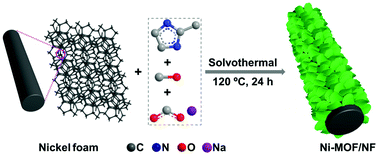In situ growth of well-aligned Ni-MOF nanosheets on nickel foam for enhanced photocatalytic degradation of typical volatile organic compounds†
Abstract
Exploitation of highly efficient catalysts for photocatalytic degradation of volatile organic compounds (VOCs) under visible light irradiation is highly desirable yet challenging. Herein, well-aligned 2D Ni-MOF nanosheet arrays vertically grown on porous nickel foam (Ni-MOF/NF) without lateral stacking were successfully prepared via a facile in situ solvothermal strategy. In this process, Ni foam could serve as both a skeleton to vertically support the Ni-MOF nanosheets and a self-sacrificial template to afford Ni ions for MOF growth. The Ni-MOF/NF nanosheet arrays with highly exposed active sites and light harvesting centres as well as fast mass and e− transport channels exhibited excellent photocatalytic oxidation activity and mineralization efficiency to typical VOCs emitted from the paint spray industry, which was almost impossible for their three-dimensional (3D) bulk Ni-MOF counterparts. A mineralization efficiency of 86.6% could be achieved at 98.1% of ethyl acetate removal. The related degradation mechanism and possible reaction pathways were also attempted based on the electron paramagnetic resonance (EPR) and online Time-of-Flight Mass Spectrometer (PTR-ToF-MS) results.

- This article is part of the themed collections: Advanced Nanomaterials for Energy Conversion and Storage and Nanoscale Most Popular 2020 Articles


 Please wait while we load your content...
Please wait while we load your content...